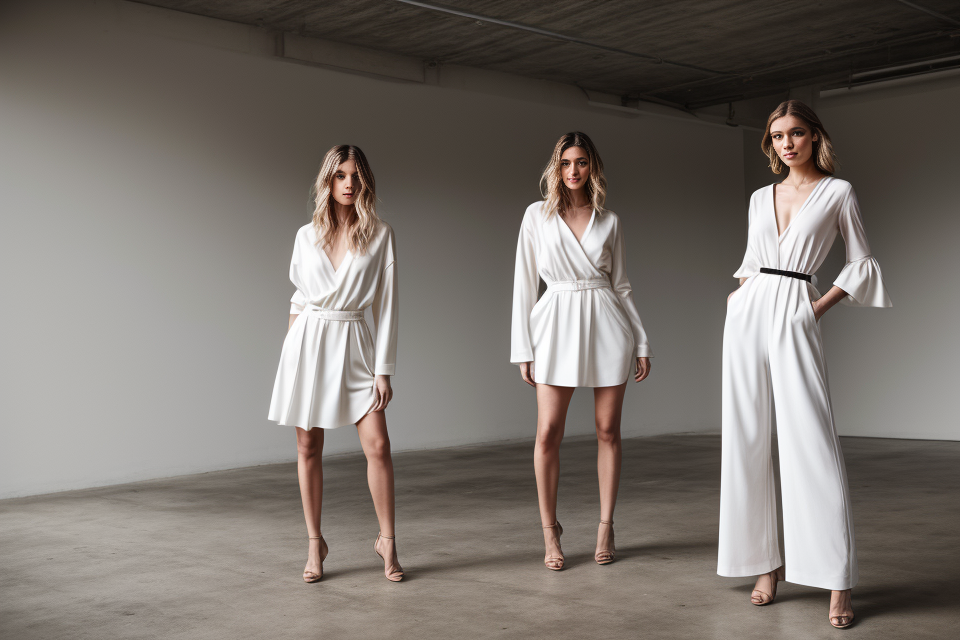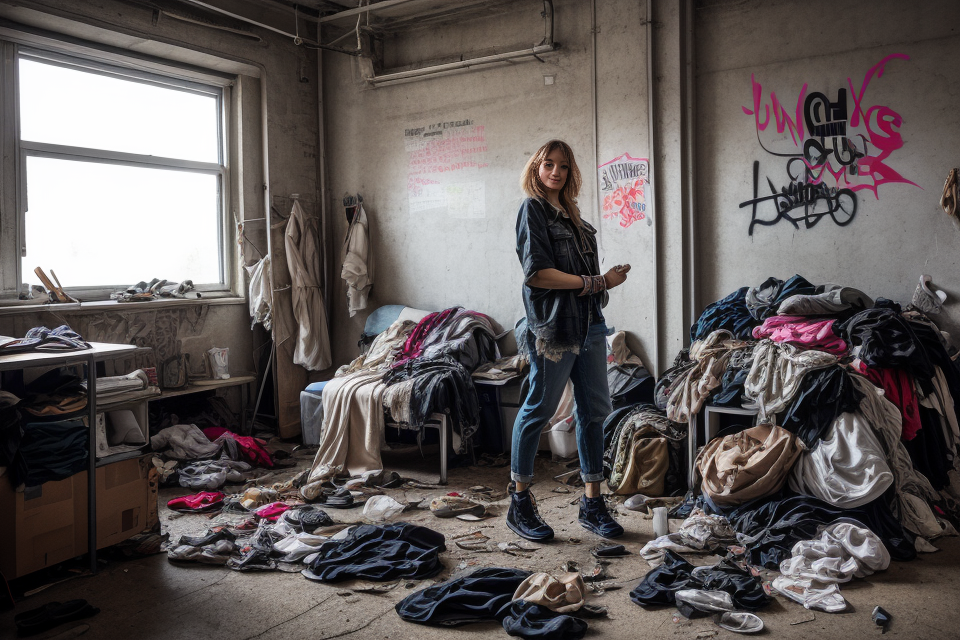
Who cares about sustainable fashion? This is a question that is increasingly being asked as the world becomes more aware of the environmental impact of the fashion industry. In recent years, there has been a growing movement towards eco-friendly fashion, with more and more people realizing the importance of sustainable practices in the fashion industry. From reducing waste and pollution to supporting ethical labor practices, sustainable fashion is becoming a crucial part of our world. In this article, we will explore the reasons why sustainable fashion matters and why everyone should care about it. So, let’s dive in and discover the importance of eco-friendly fashion in today’s world.
Why Sustainable Fashion Matters
The Environmental Impact of Fast Fashion
- Textile waste and pollution
- The fashion industry is one of the largest polluters in the world, with textile waste making up a significant portion of this pollution.
- The fast fashion model, which prioritizes rapid production and consumption, has exacerbated this problem by encouraging the production of more and more clothes, many of which end up in landfills.
- Textile waste not only takes up space in landfills, but it also releases harmful chemicals into the environment as it decomposes.
- Water and energy consumption
- Fast fashion companies often rely on unsustainable sources of water and energy to power their factories and transport their goods.
- The textile industry is one of the largest consumers of water worldwide, with some estimates suggesting that it takes 2,700 liters of water to produce a single t-shirt.
- The transportation of clothing from one place to another also contributes to greenhouse gas emissions and climate change.
- Chemical usage and harm to workers
- The use of chemicals in the production of clothing, including dyes, finishes, and cleaning agents, can have harmful effects on both the environment and the people who work in the industry.
- Many fast fashion companies have been criticized for using toxic chemicals that can contaminate water sources and harm workers’ health.
- Additionally, the fast fashion model often relies on low-wage labor in developing countries, where workers may be exposed to hazardous working conditions and insufficient protection.
The Case for Sustainable Fashion
Reducing Environmental Impact
- Fashion industry is one of the largest polluters in the world, contributing to approximately 10% of global carbon emissions.
- Sustainable fashion aims to reduce this impact by promoting eco-friendly materials, reducing water usage, and minimizing waste.
- Using organic cotton, recycled materials, and other sustainable fabrics can significantly reduce the environmental footprint of the fashion industry.
Promoting Ethical Labor Practices
- Many fashion brands have been criticized for exploiting workers, paying low wages, and violating human rights.
- Sustainable fashion brands prioritize fair labor practices, ensuring that workers are paid a living wage and are treated with dignity and respect.
- This helps to create a more equitable fashion industry and promotes social justice.
Supporting a Circular Economy
- Traditional fashion models rely on a linear system of production and disposal, where resources are extracted, used, and discarded.
- Sustainable fashion promotes a circular economy, where resources are kept in use for as long as possible, and waste is minimized.
- This includes practices such as upcycling, recycling, and using sustainable materials that can be easily repurposed or recycled.
Overall, the case for sustainable fashion is strong, as it promotes environmental sustainability, ethical labor practices, and a circular economy. By choosing eco-friendly fashion, consumers can make a positive impact on the world and support a more sustainable future.
Key Players in Sustainable Fashion
Eco-friendly fashion brands
Eco-friendly fashion brands play a crucial role in the sustainable fashion industry. These brands prioritize sustainability and ethical practices in their production processes, using eco-friendly materials and minimizing waste. They often work with suppliers who share their commitment to sustainability and ethical labor practices. Some notable eco-friendly fashion brands include Patagonia, Eileen Fisher, and Everlane.
Sustainable fashion influencers
Sustainable fashion influencers are individuals who use their platforms to promote eco-friendly fashion and sustainable lifestyle choices. They often share tips on how to reduce one’s environmental impact through fashion choices, such as buying second-hand clothing, upcycling, and choosing brands that prioritize sustainability. Some prominent sustainable fashion influencers include Blake Lively, Emma Watson, and Olivia Wilde.
NGOs and advocacy groups
NGOs and advocacy groups play a vital role in promoting sustainable fashion and holding the industry accountable for its environmental and social impacts. These organizations work to raise awareness about the negative effects of fast fashion and the importance of sustainable practices. They also advocate for policy changes that promote sustainability and hold brands accountable for their environmental and social impacts. Some notable NGOs and advocacy groups in the sustainable fashion space include the Clean Clothes Campaign, Fashion Revolution, and Greenpeace.
The Consumer’s Role in Sustainable Fashion
Changing Consumer Behavior
As consumers, we have the power to make a significant impact on the fashion industry’s sustainability. By changing our behavior, we can support eco-friendly fashion and contribute to a more sustainable future. Here are some ways we can change our behavior to promote sustainable fashion:
Shopping Consciously
One of the most significant changes we can make is to shop consciously. This means being mindful of the products we buy and the impact they have on the environment. By choosing sustainable and eco-friendly products, we can reduce our carbon footprint and minimize our impact on the environment. Some ways to shop consciously include:
- Buying high-quality, long-lasting products that require less frequent replacement
- Purchasing products made from sustainable materials, such as organic cotton or recycled polyester
- Supporting local and small businesses that prioritize sustainability
Reducing Textile Waste
Another way to promote sustainable fashion is to reduce textile waste. The fashion industry is one of the largest polluters in the world, and a significant contributor to textile waste. By reducing the amount of textile waste we produce, we can help minimize the industry’s impact on the environment. Some ways to reduce textile waste include:
- Donating or selling clothes we no longer wear or need
- Recycling old clothes or fabrics
- Repurposing old clothes or fabrics into new products
Supporting Sustainable Brands
Finally, we can support sustainable brands by choosing to buy from them. Sustainable brands prioritize eco-friendly practices and materials, and by supporting them, we can help promote sustainability in the fashion industry. Some ways to support sustainable brands include:
- Researching and choosing brands that prioritize sustainability
- Supporting sustainable fashion through social media and word-of-mouth
- Writing reviews and sharing our experiences with sustainable brands
By changing our behavior and adopting these practices, we can contribute to a more sustainable future for fashion.
The Future of Sustainable Fashion
As consumers become increasingly aware of the environmental impact of their purchasing decisions, sustainable fashion is poised to become a mainstream trend. Innovations in eco-friendly materials, circular fashion models, and the rise of ethical fashion are just a few of the developments that are shaping the future of sustainable fashion.
Innovations in Eco-Friendly Materials
One of the most exciting developments in sustainable fashion is the proliferation of eco-friendly materials. These materials are designed to minimize the environmental impact of clothing production, from seed to disposal. For example, companies like Levi’s are experimenting with jeans made from organic cotton and recycled water, while Adidas is developing shoes made from mushrooms. These innovations are not only more sustainable, but they also offer consumers high-quality, long-lasting products that are both functional and stylish.
Circular Fashion Models
Circular fashion models aim to minimize waste by creating a closed-loop system for clothing production. This involves designing clothes that can be easily repaired, recycled, or upcycled, as well as developing systems for collecting and recycling clothing at the end of its life. Brands like H&M are leading the way in this area, with programs like their Garment Collecting initiative, which encourages customers to recycle their old clothes in-store. As circular fashion models become more widespread, they have the potential to transform the fashion industry and create a more sustainable future for everyone.
The Rise of Ethical Fashion
Finally, the rise of ethical fashion is also shaping the future of sustainable fashion. Ethical fashion brands prioritize transparency, fair labor practices, and sustainability in their production processes. As consumers become more aware of the human rights abuses and environmental degradation that can occur in the fashion industry, they are increasingly seeking out ethical brands that align with their values. Companies like Everlane and Patagonia are leading the way in this area, offering consumers high-quality, sustainable products that are also ethically produced.
In conclusion, the future of sustainable fashion is bright, with innovations in eco-friendly materials, circular fashion models, and the rise of ethical fashion all pointing towards a more sustainable future for the industry. As consumers become more aware of the environmental and social impact of their purchasing decisions, sustainable fashion is poised to become a mainstream trend, offering both style and sustainability.
Sustainable Fashion for All
Making Sustainable Fashion Accessible
One of the key challenges in promoting sustainable fashion is making it accessible to a wider audience. While eco-friendly clothing and accessories are becoming increasingly popular, they are often priced out of reach for many consumers. To make sustainable fashion accessible to all, several strategies can be employed:
- Affordable eco-friendly options: Brands are beginning to realize that sustainability does not have to come at a premium price. Many companies are now offering affordable eco-friendly options, such as organic cotton T-shirts and recycled polyester dresses. By making sustainable fashion more affordable, more people can incorporate it into their wardrobes.
- Second-hand clothing: One of the most sustainable ways to shop is to buy second-hand clothing. Not only does it reduce waste and carbon emissions, but it is also often more affordable than buying new clothes. Thrift stores, consignment shops, and online second-hand marketplaces are great places to find gently used clothing at a fraction of the cost of new clothes.
- Sustainable fashion rental services: Another way to make sustainable fashion accessible is through rental services. By renting clothes instead of buying them, consumers can experiment with different styles and brands without committing to the cost of purchasing. Rental services also promote sustainability by reducing waste and encouraging the sharing of clothing. Some popular sustainable fashion rental services include Rent the Runway, Le Tote, and Nuuly.
Sustainable Fashion for Different Lifestyles
- Athleisure and activewear
- Luxury sustainable fashion
- Streetwear and sustainable fashion
Sustainable fashion has become a growing trend in recent years, and it is no longer just for a select few. It is now accessible to people from all walks of life, and there are many different styles of sustainable fashion to choose from. Here are some examples of how sustainable fashion can be incorporated into different lifestyles:
Athleisure and Activewear
Athleisure and activewear are two areas where sustainable fashion is becoming increasingly popular. Many people who lead active lifestyles are looking for clothing that is comfortable, functional, and sustainable. Some brands that are making a difference in this area include:
- Adidas: Adidas has launched a line of sustainable activewear called “Adidas x Parley for the Oceans.” This line uses recycled ocean plastic to create sustainable athletic wear.
- Patagonia: Patagonia is a brand that has been committed to sustainability for many years. They offer a wide range of sustainable activewear, including fleece jackets, pants, and shorts.
- The North Face: The North Face has also launched a line of sustainable activewear called “Eco Trail.” This line is made from recycled materials and is designed to be durable and long-lasting.
Luxury Sustainable Fashion
Luxury sustainable fashion is a growing trend in the fashion industry. Many luxury brands are now offering sustainable fashion options, and this trend is expected to continue to grow in the coming years. Some luxury brands that are making a difference in this area include:
- Stella McCartney: Stella McCartney is a luxury brand that is committed to sustainability. They offer a wide range of sustainable fashion options, including dresses, suits, and accessories.
- Gucci: Gucci has launched a line of sustainable fashion called “Gucci Equator.” This line is made from organic cotton and recycled materials.
- Prada: Prada has also launched a line of sustainable fashion called “Prada Ccircuit.” This line is made from recycled materials and is designed to be sustainable and long-lasting.
Streetwear and Sustainable Fashion
Streetwear is a popular style of fashion that is often associated with urban culture. Sustainable fashion is now being incorporated into streetwear, making it more accessible to people who may not have considered sustainable fashion in the past. Some brands that are making a difference in this area include:
- Converse: Converse has launched a line of sustainable streetwear called “Converse Renew.” This line is made from recycled materials and is designed to be durable and long-lasting.
- Nike: Nike has also launched a line of sustainable streetwear called “Nike VaporVerse.” This line is made from recycled materials and is designed to be sustainable and stylish.
- Puma: Puma has launched a line of sustainable streetwear called “Puma Forever.” This line is made from organic cotton and recycled materials.
In conclusion, sustainable fashion is no longer just for a select few. It is now accessible to people from all walks of life, and there are many different styles of sustainable fashion to choose from. Whether you lead an active lifestyle, enjoy luxury fashion, or prefer streetwear, there are many options available to you. By choosing sustainable fashion, you can make a positive impact on the environment and help to create a more sustainable future for all.
The Need for Collective Action
Government policies and regulations
- Encouraging sustainable practices within the fashion industry
- Setting environmental standards for clothing production
- Implementing circular economy principles
Industry-wide changes
- Adopting eco-friendly materials and production methods
- Promoting transparency in supply chains
- Encouraging ethical labor practices
Individual responsibility
- Conscious consumerism
- Reducing waste and overconsumption
- Supporting sustainable brands and initiatives
FAQs
1. Who cares about sustainable fashion?
Everyone should care about sustainable fashion. Sustainable fashion is about creating and consuming fashion in a way that minimizes harm to the environment and promotes ethical practices. It is not just about buying organic cotton or using natural dyes, but also about considering the entire lifecycle of a garment, from production to disposal. Sustainable fashion is for anyone who cares about the planet and wants to make a positive impact on the environment.
2. Why is sustainable fashion important?
Sustainable fashion is important because the fashion industry is one of the most polluting industries in the world. It is responsible for a significant amount of water pollution, carbon emissions, and waste generation. By choosing sustainable fashion, consumers can reduce their environmental impact and support more ethical and sustainable practices in the fashion industry. Additionally, sustainable fashion promotes the use of high-quality materials and ethical labor practices, which can improve working conditions for garment workers.
3. What is the difference between sustainable and fast fashion?
Sustainable fashion is the opposite of fast fashion. Fast fashion is characterized by fast production cycles, low-quality materials, and low labor standards. It prioritizes trendiness and low prices over sustainability and ethical practices. Sustainable fashion, on the other hand, prioritizes quality, durability, and sustainability. It encourages consumers to invest in fewer, higher-quality garments that will last longer and have a lower environmental impact.
4. How can I incorporate sustainable fashion into my wardrobe?
Incorporating sustainable fashion into your wardrobe can be as simple as making a few small changes. Here are some tips:
- Shop secondhand: Secondhand clothing is a great way to reduce your environmental impact and save money. Look for high-quality, timeless pieces that will last for years.
- Choose sustainable brands: Look for brands that prioritize sustainability and ethical practices. These brands often use eco-friendly materials and fair labor practices.
- Care for your clothes: Properly caring for your clothes can help them last longer and reduce your environmental impact. Wash your clothes in cold water, line dry them, and consider mending or upcycling damaged clothes instead of throwing them away.
- Buy less, buy better: Instead of buying a lot of cheap, low-quality clothes, invest in a few high-quality, timeless pieces that will last for years.
5. Is sustainable fashion more expensive than regular fashion?
Sustainable fashion can be more expensive than regular fashion, but it doesn’t have to be. Sustainable fashion can be affordable if you know where to look and what to look for. Look for brands that offer affordable, sustainable options, and consider secondhand clothing, which can be very affordable and sustainable. Additionally, investing in high-quality, timeless pieces can save you money in the long run, as they will last longer and require less frequent replacement.


